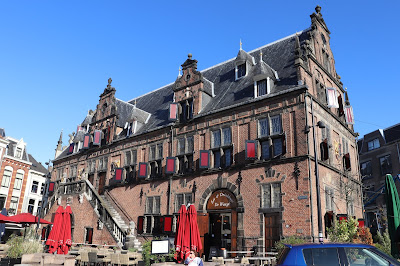Our ship was docked about 15 minutes from the city center,
making it easy to tour the major squares as well as the side alleys in town. Antwerp is a major shipping
port in Europe, second only to Rotterdam. An interesting feature next to our
ship was the world's oldest escalator made of wood and leading to a pedestrian
tunnel underneath the river. We saw lots of chocolate stores, liquor stores
featuring some of Belgium's 1000 beers, and snack shops featuring Belgian Fries
and sausages. The Belgians are proud of their fries which are fried twice.
Our first square was the Grote Market
with the guild houses lining the square and an interesting Brabo Fountain in the
center featuring a figure holding a cut off hand. This represents the legend of
the giant Druon Antigoon, who cut off a hand of all ship captains who refused
to pay the toll. But then was surprised by Brabo, a captain of the Roman Army,
who cut of Druon’s hand and his handless body lies bleeding at the base of the
fountain. This story is celebrated by chocolate shaped like a hand (which of
course we sampled).
 |
Raising of the Cross by Reuben |
 |
Church Bar |
In the afternoon, we got to watch an Argentine Navy Trainer
Tall ship ceremoniously set sail right in front of us. We ended our day with a great
Captain's dinner and went to bed early for the early start to the airport.
Euthanasia Discussion
Our afternoon speaker introduced us to the fact that
Euthanasia is legal in Belgium (as well as the Netherlands and Luxembourg).
They consider it a way to have a dignified death when dealing with unbearable
or unending pain. The individual is the decision maker and the doctor has the
right to not participate. After signing a paper, that you desire to be
euthanized, the doctor must review your options for the future and ask for a 2nd
opinion. In Belgium, it is not necessary for you to be terminally ill to ask,
but you must have a physical or mental problem. There is no age restriction,
but for minors, the parents must agree. But you must be able to make a decision
when the chemicals are given to you, so this is a problem for people with
dementia. Legally, euthanasia is a form
of natural death for insurance and criminal law purposes. About 2% of Belgium’s
deaths are via euthanasia.
Of course, there are many people opposed to euthanasia.
The primary cons are:
·
Religious reasons, that this is suicide
·
Fear of forced euthanasia
·
No recourse “what is done, is done”
·
Pressure from family “I’m a burden to them”
Trip Summary
A 23 minutes video of this trip is available on youtube.
Overall, this has been a relaxing cruise. Each day started with a walking tour of a new town, followed by time to explore further on your own or just relax on the ship. We met some great people on the ship, and had fun joking around with each other. Jörn our program manager had a story or joke for every occasion as well as sharing the facts about each location. Finally, Captain Richard was always available, welcoming us every time we returned to the ship.
Overall, this has been a relaxing cruise. Each day started with a walking tour of a new town, followed by time to explore further on your own or just relax on the ship. We met some great people on the ship, and had fun joking around with each other. Jörn our program manager had a story or joke for every occasion as well as sharing the facts about each location. Finally, Captain Richard was always available, welcoming us every time we returned to the ship.
















































